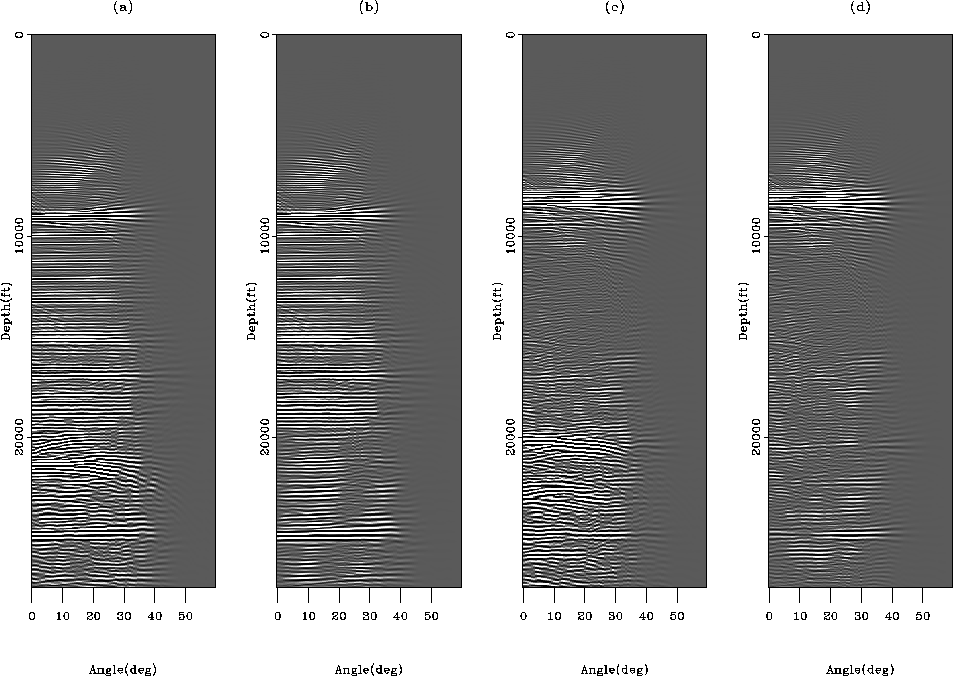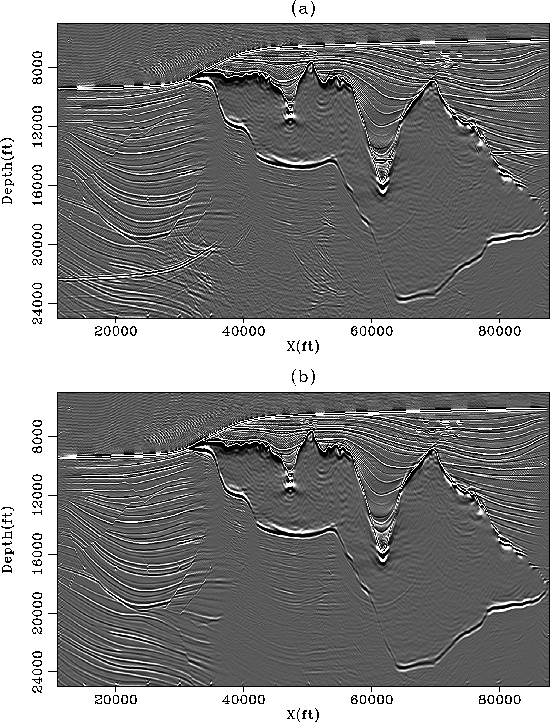




Next: Estimating biases
Up: Guitton: Sigsbee2B
Previous: Filter estimation
The Sigsbee2B dataset was designed to generate strong surface-related
multiples. Figure 1 shows the true stratigraphic
interval velocity model for this dataset. The data were created with a 2D
acoustic finite difference modeler with constant density. Two datasets
were generated: one with a free surface (Figure 2a)
and one without a free surface (Figure 2b).
These two datasets are such that a direct subtraction of the two
leads to an almost true prestack model of the surface-related
multiples. Because this multiple attenuation technique deals
with the subtraction step only, the multiple model obtained by
subtraction of the two datasets with and without free-surface conditions
is used for the noise PEFs estimation for all my computations.
As stated in the introduction, I focus my analysis in the image
space after migration. In complex geology, multiple
attenuation results should always be assessed after migration;
the effects of the multiple
attenuation technique on the amplitudes of the primaries in ADCIGs
(e.g., Figure 3), or on migrated
images at zero offset (e.g., Figure 4) can be
then directly assessed.
For the Sigsbee2B dataset, a split-step double square-root
(DSR) migration code with three reference velocities is used.
Ideally, because the data were created with finite differences, a
finite differences migration code should be used to take the full
complexity of the wave propagation into account. Figure
3d illustrates the limits of the migration
algorithm by showing non-flat events below the salt. In contrast,
Figure 3b displays flat gathers in the
sedimentary section left of the salt body. An illumination effect is
clearly visible below 20,000 ft, between 20 and 30 deg in
Figure 3b. Figures
3a and 3c highlight
the effects of the multiples on ADCIG by creating numerous artifacts
and fictitious events.
It is interesting and somewhat surprising to
see that in Figure 4a the multiples are very
weak after migration below the salt compared to the constant offset
sections in Figure 2a. In particular, the water
bottom multiple seems to disappear. This is because the
multiples are extremely distorted by the migration process in the
vicinity of the complex salt structure. Compared with the migration
of the primaries only in Figure 4b, the
multiples in Figure 4a
are masking a lot of primaries in the deepest part of the model
and thus need to be removed.
datasignal2-ang
Figure 3 ADCIGs for the migrated data
at two different surface locations inside (i.e., 33 kft) and outside
(i.e., 30 kft) the salt boundaries. (a) ADCIG at 30 kft for the data
with multiples. (b) ADCIG at 30 kft for the data without multiples.
(c) ADCIG at 33 kft for the data
with multiples. (d) ADCIG at 33 kft for the data without
multiples. Theoretically, with the appropriate migration algorithm,
this last gather should be flat everywhere.
![[*]](http://sepwww.stanford.edu/latex2html/movie.gif)
 datasignal-mig
datasignal-mig
Figure 4 Migrated images at zero-offset for
the data with (a) and without (b) free surface condition. Comparing with
Figure 2, the multiples appear much weaker below
the salt after migration. However, some reflectors near 22 kft are
hidden in (a).
![[*]](http://sepwww.stanford.edu/latex2html/movie.gif)

In the next section, I demonstrate that in the ideal case where a
model for both the primaries and multiples exist, the primaries can be
recovered with almost no bias from the attenuation technique. Then,
without any model for the primaries, I show that the Spitz
approximation gives an excellent multiple attenuation result when 3D
filters are used.

![[*]](http://sepwww.stanford.edu/latex2html/movie.gif)
